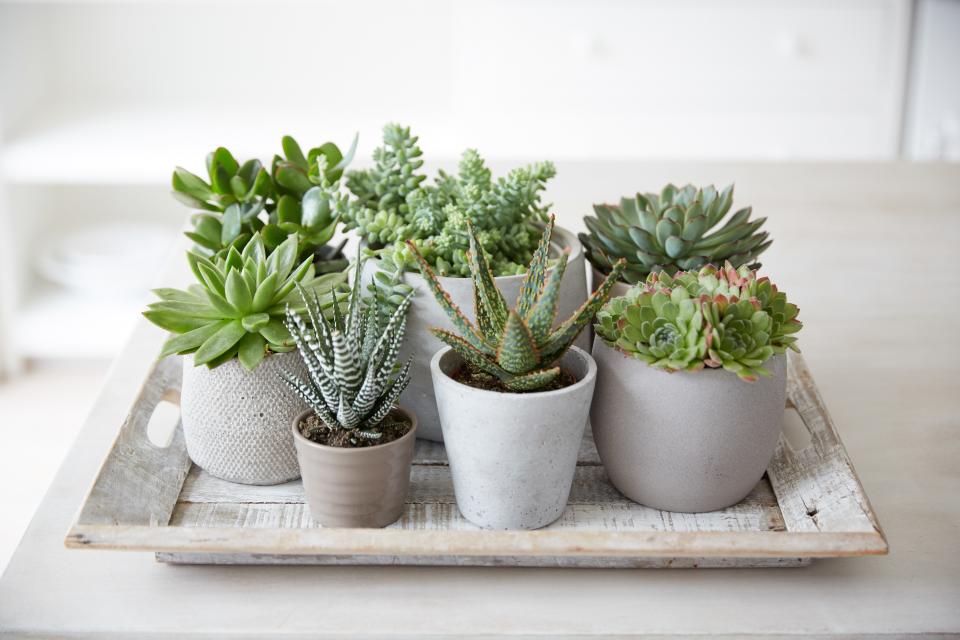Everything You Need to Know About Succulent Gardens
The only thing better than a beautiful succulent plant is a gorgeous succulent garden. "Whether planted in an area of your outdoor garden or placed together indoors in different containers, succulents look great in groups," says plant expert James McCann of Plants.com. "Get creative and combine forms and colors for an inspired design. Their unusual colors, textures, and forms make living art objects in any home or garden."
Along with creating visual interest, succulent gardens are also incredibly easy to care for. "Succulents are drought-tolerant plants, and generally only need [to be] watered once a week during the warm weather months, or every two weeks when it's colder outside," says Ha Le, co-founder of Succulents Box. "Succulent gardens are usually a lot more low-maintenance than traditional gardens." Interested in growing and caring for your own succulent garden at home? From the best succulents to use to planting tips and more, McCann and Le share their insight.
Related: How to Keep Your Succulents Alive

Getty Images
Start by choosing the best succulents for your garden.
Of course, while choosing the succulents for your garden depends upon your personal preferences, Le says picking ones with similar maintenance requirements helps to ensure a successful outcome. "It's best to group plants that have the same lighting and watering needs together to avoid root rot," he explains.
Additionally, Le says that some popular succulent species, such as agave and aloe, can grow quite large, so it's crucial to provide them with plenty of space in an outdoor garden. "If you have limited space, you should only plant one or two of those as the centerpiece, then surround them with smaller species such as a rosette-shaped Echeveria, stacked Crassula plants, and stonecrop-style Sedum."
Make sure your succulent garden receives at least six hours of sunlight.
Most succulents prefer bright, indirect light so it's important to plant or place them in an area that receives at least six hours of sunlight a day. "Outdoors, this would be a place that sees plenty of direct sunlight in the morning, and shade in the afternoon," Le explains. "Indoors it would be a south-facing window that receives lots of sunlight."
When growing succulents indoors, McCann says it's a good idea to regularly rotate the pots to ensure all sides of the plant receive light. "If plants grow tall and skinny rather than short and wide, it's a sign that they are not getting enough light," he adds.
Ensure good soil drainage before planting your succulent garden.
Succulents do best in well-draining soil, so prepping your soil before planting them outdoors is key. "If you have clay soil, it is recommended that you put at least five inches of new succulent soil on top of the existing clay soil to provide the best growing conditions for your succulents," Le says. "Clay soil is hard and does not absorb or drain water very well, so the delicate succulent roots could rot."
For indoor succulent gardens, Le says a solid mix of 50-percent soil and 50-percent inorganic matter, such as perlite or pumice, will ensure good drainage. "To test if your soil is porous enough, make a soil ball in your hand and wet it," he says. "If the ball stays intact, then the soil needs more perlite (or inorganic matter)."
Be selective about containers.
The containers you plant your succulents in can make or break how well your indoor garden grows. "Any container that has drainage will work, but terra cotta pots are often recommended for first time succulent parents," McCann explains. "They are porous and contribute to good drainage, which is necessary for this group of plants."
According to Le, selecting the appropriate size of container for your succulent is also crucial. "Make sure the container is not too big for your plant, because it will increase the chance of overwatering and make it harder for the roots to develop." A general rule of thumb is to pick a pot that is about 10-percent bigger than the size of the succulent at the surface.
Water carefully.
Whether indoors or outdoors, Le says the most important thing you can do for your succulent garden is to avoid overwatering it. "Always remember to water deeply, or until the water runs out from the drainage hole," he advises. "And only water your succulents when the soil is completely dry."

